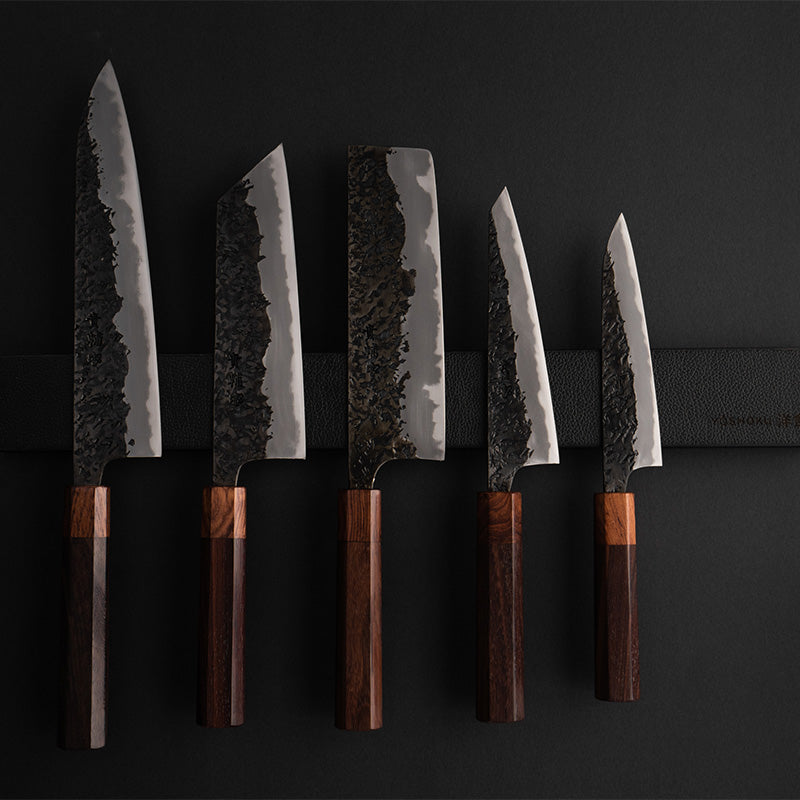
A Guide to Japanese Knives (2021)
A Guide to Japanese Knives
In the culinary world, Japanese knives are highly praised. We're here to tell you that they truly live up to the hype. Japanese knives are the product of a rich culture. Skilled artisans use the finest materials and techniques to make these high-quality tools. Many varieties are available that serve different purposes in the kitchen.
Looking to add Japanese knives to your arsenal? We don't blame you. These tools make a great addition to your kitchen. They also go a long way in helping you prepare authentic cuisine.
Not sure how to find the right Japanese knife in Australia? You're not alone. It can be tricky when you're not familiar with these traditional tools. Luckily, we're here to help!
Here's a complete guide to Japanese knives. We'll go over different materials, varieties, and more to help you become an informed buyer.
Western vs. Japanese Knives
Before diving in, it's worth mentioning the main differences between Western and Japanese knives.
Material Quality
Western knives are easier to care for. They aren't as brittle and won't rust as easily. Their Japanese counterparts require more care as they are more brittle and prone to rust. However, they tend to be sharper and hold their edge longer.
Blade Shape
Traditional Japanese knives have a single-bevelled blade, where one side is sharpened, and the other side is completely flat. A chef uses this blade to make precise diagonal cuts. Note that because just one side of the blade is sharpened, a single-bevelled knife is made for right-handed chefs. If you are left-handed, you will have to get a specialty leftie knife (which can be more expensive).
Western knives, on the other hand, usually have double-bevelled blades. They are sharpened on both sides, resulting in a V-shaped blade edge. Though easier to sharpen, this blade isn't as good for high-precision cuts. But, you'll be glad to hear that double-bevelled blades are ambidextrous by design. Both left- and right-handed chefs can use them with ease.
Know the Different Materials
Now, let's take a look at the different materials Japanese knives are made out of.
Carbon Steel
Relatively speaking, carbon steel is sharper and less resistant to wear. When it does become dull, it's easier to sharpen.
Carbon steel is also more brittle and prone to rust. Professional chefs are more likely to own carbon steel knives to keep up with the required maintenance.
Stainless Steel
Compared to carbon steel, stainless steel isn't as sharp. As a result, it is prone to wear and slightly more difficult to sharpen.
Stainless steel, however, has many perks. It is easier to care for as it isn't as brittle or prone to rust. This makes it a popular choice among amateur chefs.
Different grades of stainless steel knives (VG-10, 10A, or AUS-10, etc.) offer unique hardness and edge retention levels.
Damascus Steel
Traditional Damascus steel is no longer made. Modern manufacturers, however, attempt to replicate the historical material.
Damascus steel knives can be made out of either carbon or stainless steel. Their key feature is their beautiful water-like patterns. Many chefs prefer knives made out of this material for aesthetic reasons.
If you are buying a Japanese knife in Australia, consider whether you want a carbon or stainless steel knife. Then, decide if you want a standard design or a beautiful Damascus pattern.
Find the Right Japanese Knife in Australia
The type of material you choose is important. However, you'll also want to find a knife of the right size and shape for what you'll be using it for.
Here are some of the most popular types of Japanese knives:
Gyuto
A Gyuto is not necessarily a traditional Japanese knife. It is a Japanese adaptation of the Western chef's knife.
A Gyuto has a curved blade, tall heel, and pointed tip. Its blade is usually around 210-270mm in length. While chefs use it for various applications, a Gyuto is particularly useful for piercing and rocking motions.
Garasuki
A Garasuki is another Japanese adaptation. It mimics a Western boning knife.
The triangular blade is tough and has a sharp tip. While not good for cutting through bones, it is great for maneuvering around tight spaces. Chefs often use it to break down poultry and red meat.
Honesuki
A Honesuki is essentially a smaller version of a Garasuki.
Santoku
A Santoku (along with the rest of the knives we'll be discussing) is a traditional Japanese knife.
A Santoku is similar to a Gyuto in that it is all-purpose. The name, translating to “three virtues,” refers to its ability to cut meat, fish, and vegetables. With a Santoku, chefs tend to use an up-and-down motion rather than a rocking motion.
Nakiri
A Nakiri is for cutting, slicing, and peeling vegetables. The double-bevelled blade, which can be between 240-300mm, is thin and straight.
Usuba
An Usuba is the single-bevelled version of a Nakiri. Its blade is much thinner, making it perfect for decorative cuts and paper-thin slices.
Takohiki
Chefs use a Takohiki to slice raw fish for sashimi. The blade is rectangular.
Yanagiba
A Yanagiba is also used to slice raw fish for sashimi. The blade, however, is slim, long, and has a curved tip.
Deba
A Deba is for breaking down fish. The chunky blade can cut through bones, descale, etc. A standard size Deba (Hondeba) has a blade length of 210mm.
Unagisaki
A Unagisaki is for preparing Unagi. The sharp tip can pierce through the slippery eel's skin and filet the fish.
Menkiri
Chefs use a Menkiri to cut through soba noodles and udon. A Menkiri is heavy, has a straight edge, and features a blade that extends to the handle.
Buy Your Japanese Knife in Australia
With the help of this guide, you should find the perfect Japanese knife in Australia. Just keep in mind that these knives are crafted with care, and you'll need to keep them in pristine condition if you want to get your money's worth.
